Beth Kephart's Blog, page 159
October 15, 2012
Small Damages on The Yalsa Hub
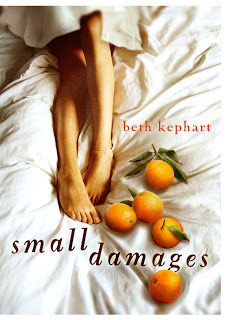
My thanks to Sarah Laurence for letting me know that Small Damages (Philomel) was among those titles discussed by Kelly Jensen at The Yalsa Hub, in a story entitled: "The Next Big Thing: Contemporary/Realistic Fiction).
For the whole story, which looks at all the contemporary/realistic books nominated for this year's Best Fiction for Young Adults, go here.




Published on October 15, 2012 13:10
saying no
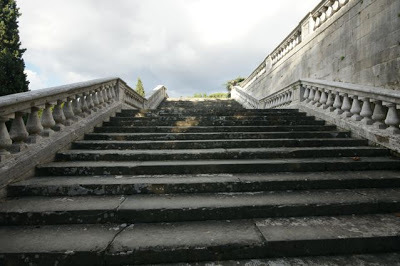
Every now and then even middle children stop and say, "Enough." Or, "I need to do what is right for me." Or, "No, I will not be made a fool, or at least more of a fool than I already am." Or, "No. Really. That wasn't all right."
I did that this weekend. Stepped back, assessed, and said (politely) no.
I do this so rarely, so twice-a-year tops, that is always shocking, even to me, when I step forward, boldly, to declare what it is that I actually want. Writing to my son, telling him the story, he wrote back, encouraging, as he does.
Sometimes you have to do what is right for you, he said. And if you can do it kindly, all the better.




Published on October 15, 2012 06:09
October 14, 2012
The Push to Publish YA/Children's Book Panel: the questions we asked and answered
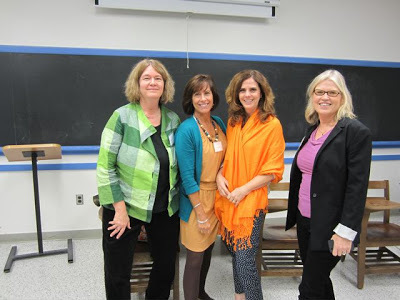
Before Catherine Stine, Nancy Viau, Alison DeLuca, and I met yesterday afternoon at Rosemont College for our Push to Publish YA/Children's Book Panel, we were invited to submit questions and answers for potential mulling during our panel. As the group's moderator, I promised the audience that I would share those very questions and answers here, to supplement the many other things we discussed during our it-flew-by-so-fast hour.
Many thanks to all of you who came, to Catherine, Nancy, and Alison, who spoke so intelligently, and to Christine Weiser, Queen of Philadelphia Stories (from which the annual Push to Publish conference springs), who took this photograph for us.
Catherine Stine:
1. How important is social media
to your promo plan and when should you start to implement it?
The best advice I got from an early mentor was to start a blog way before my
next big book came out, not when it
came out. I started Catherine Stine’s Idea City about two years before my
latest novel was published, and by that time I had over 340 followers, who
helped with my book blog tour, and other promo posts such as interviews,
features and giveaways, as well as me guest posting on their blogs.
I had no idea that the blogosphere would be so friendly and eager to help. Part
of the fun is that it’s a mixed age-community, with everyone from savvy book
reviewers, still in high school, to seasoned authors in their sixties. The key
is to care about what others are posting! If you want good comments on your
posts, you must return the favor.
I’ve learned so much about publishing and writing from this vibrant community,
and from indie authors as well as ones who are published with the Big Six.
Other important social media to develop: a Goodreads author page, a Facebook
author or book page, a Pinterest page and a twitter account. There are others,
but this is a great place to start!
Topical online reads:
1. Publishers’ Weekly article on YA Marketing-Digital versus Physical:
http://www.publishersweekly.com/pw/by-topic/industry-news/bea/article/52455-bea-2012-ya-marketing-digital-vs-physical.html
2. Basic
Marketing Tips from YA author, Elana Johnson:
http://elanajohnson.blogspot.com/2012/02/basic-marketing-plan-for-authors-who.html
3. What the heck
is Pinterest, you ask? Check out a sampling of YA books for OCT on Pinterest! http://pinterest.com/BCSPLS/october-2012-children-teen-ebooks/
2. What are the big differences between
indie and traditionally published books/authors? Between ebooks and paper
copies? How do you see these trending in the future?
I see a blending in the future of who is published traditionally to who is
publishing on their own, or with small houses. It will be more about the quality of the fiction and the authors’ growing readership than how authors publish. I’ve
published with big houses such as Random House and American Girl, and I’ve also
published through my own Konjur Road Press. Many traditionally published
authors are now publishing their own out-of-print-books and novels that their
agents haven’t placed. As publishing houses become more gun-shy and picky
(because of less physical bookstores to sell to!) and authors learn how much
they can potentially earn on their own the quality of indie fiction will grow
ever higher! There is also a trend toward POD printing—that means print on
demand. For instance, if someone orders your POD book through Amazon, or
B&N, their publishing arm will print as many paperback copies as are
ordered and no more. This has an upside for a beleaguered industry: publishers
will no longer have to deal with huge store returns, which lose money for the
houses when they must refund that revenue. On the other hand, it means less
variety on the physical bookshelves. As more and more readers get comfy with
ereading devices, more and more ebooks will sell. In the Catskills, where I go
on the weekends, I feel the burn of bookstore closings. There are no more
bookstores within 40 or 50 miles! People won’t stop reading, they will always
want stories; they will simply buy more ebooks.
Some related online articles:
1.
A post by indie
fantasy author, Lindsay Buroker:
http://www.lindsayburoker.com/tips-and-tricks/successful-indie-authors/
2.
A post by Susan Kaye
Quinn, indie YA author: http://www.susankayequinn.com/2011/09/taking-road-less-traveled-redux.html
3. Trends in YA? Write to trends or to
what I love?
It’s always a gamble to predict specific trends because they change from year
to year. And one should never, ever
write specifically to the trends. You should write that amazing novel that only
you can write! I tell my students to focus on a subject or theme that they are
totally inspired by, because maintaining fuel for those entire 250 to 350 pages
is something only fierce interest and passion can drive. That said, there do
seem to be trends for 2013/14: realistic YA is making a comeback, after a
paranormal and fantasy-saturated market. Vamps are trending out, but there will
probably always be room for that unique, geeky or charismatic vamp! Historical
fantasy is in with novels such as Revolution by Jennifer Donnelly. Magical realism
is growing, as is confidence in YA sci-fi like Black Hole Sun by Gill and space
opera, such as A. Ryan’s Glow. Horror and unusual blends are growing in
popularity as seen in novels like Miss Peregrine’s Home for Peculiar Children
by R. Riggs. There is also a trend toward sci-fi romance, as in novels like V.
Rossi’s Under the Never Sky. And then, there are the trend-busters whose
mind-bending novels start entirely new trends! Will you write one of these?
Nancy Viau
How do I avoid the slush pile?
It's the "kiss of death" to address your submission to Dear Editor,
Agent, or To Whom It May Concern. Research a name and target your manuscript to
a real person, one who is acquiring work in the genre in which you write.
There's a wealth of info to be found on websites such as www.publishersmarketplace.com http://www.publishersmarketplace.com/> (monthly subscription
is about 20 bucks), www.agentquery.com <http://www.agentquery.com/> , www.querytracker.net
<http://www.querytracker.net/> , and www.scbwi.org <http://www.scbwi.org/> . Bloggers like Casey
McCormick, www.literaryrambles.com <http://www.literaryrambles.com/> , often feature authors and
agents, and many editors and agents have blogs and are on Twitter or Facebook.
But, instead of relying only on info found on the Internet (where everything's
always correct, right? Ha!), find a better, more personal connection by going
to conferences and/or getting one-on-one critiques at conferences. Strike up a
conversation, exchange business cards, and schmooze your way to success.
What is in a query letter to an agent?
How about a cover letter to an editor?
The best way for me to answer this is to give each person copies of letters I
wrote to the above people. I'll dissect what I've included and why, and tell
the group if it was a successful or not. I feel that the best
"takeaway" is something someone can actually take away. : )
What types of picture books are
children's book editors looking for?
This is the million dollar question! Who really knows? Many agents and editors
say they want a story based on a marketable character. (Ex: FANCY NANCY,
LADYBUG GIRL, DON'T LET THE PIGEON DRIVE THE BUS). In additon, they want short
over long (less than 800 words), loud over quiet, and non-rhyming over rhyming.
They'd also like you to be a celebrity! (*Smirk*) That being said, there are
plenty of recently acquired books that break all these rules. (Ex: LOOK WHAT I
CAN DO! and STORM SONG, my two picture books due out this spring. They are not
character-based, they're considerably quiet, and they rhyme. And yes, I'm still shocked that they sold.)
Beth Kephart
What is the most surprising—or affirming—aspect of the YA
writing community?
Although I’ve taught teens for years, I never planned
to write books that were specifically set aside for that age group. It seemed, to me, like an entirely different language, a world that I would never
effectively penetrate. Now with my eighth and ninth YA novels set for release, I
have learned important things about the generosity of the YA writing
community, the fervor of librarians and teachers, and the wide open heart of
teen readers. Power—sometimes chaotic, sometimes strange, but nearly
always mesmerizing—abides in the YA community. And that is why, I think, adults increasingly lean in our direction. That is also why so many teen books increasingly refuse to stay within set boundaries. We writers of teen books want everyone to share in the magic.
Is there room for the quiet YA book?
I wasn’t sure there would be one, when I first started
writing. In fact, my kind of book was a bit of an experiment for Laura
Geringer, my first YA editor, then at HarperCollins. What would happen, she wondered, to
teen books that were deliberately focused on emotion and
mood, setting and ideas, language and light, in the age of Twilight? Would they find an audience? The good news is that there is an audience. Not a rip-roaring, I’m-going-to-be-rich-and-famous audience. But enough of an audience to enable me to keep writing my kind of book, to keep
finding my kind of teen (and adult) reader. And for that I am hugely grateful.
What is the hottest trend in YA fiction?
I have been saying for a while now that we are at long
last shedding categories with YA fiction. We are celebrating individuals who write books that break rules and boundaries. The Book Thief freed us, in that way. Writers like Patricia McCormick and A.S. King continue
to remind us how powerful the unexpected is. And of course I still believe, as I wrote last year, that illustrated YA books, along with well-written, engaging historical novels, will find firmer marketing footholds.
[image error]




Published on October 14, 2012 14:19
Larissa MacFarquhar on writing historical fiction

Larissa MacFarquhar writes pieces for The New Yorker that anyone seriously engaged with literature must read. This is the case again with her October 15 profile of Hilary Mantel, author of Wolf Hall, which begins with these reflections on the writing of historical fiction. I share the opening, urging you to find the magazine and read the essential whole.
What sort of person writes fiction about the past? It is helpful to be acquainted with violence, because the past is violent. It is necessary to know that the people who live there are not the same people now. It is necessary to understand that the dead are real, and have power over the living. It is helpful to have encountered the dead firsthand, in the form of ghosts.
The writer's relationship with a historical character is in some was less intimate than with a fictional one: the historical character is elusive and far away, so there is more distance between them. But there is also more equality between them, and more longing; when he dies, real mourning is possible.
Historical fiction is a hybrid form, halfway between fiction and nonfiction. It is a pioneer country, without fixed laws.....
On another topic altogether, I'll be posting some of the questions and answers from yesterday's Push to Publish YA panel on this blog later today. (I promise.) [image error]




Published on October 14, 2012 05:01
October 13, 2012
James Wood on Tom Wolfe's use (or not use) of meaningful detail
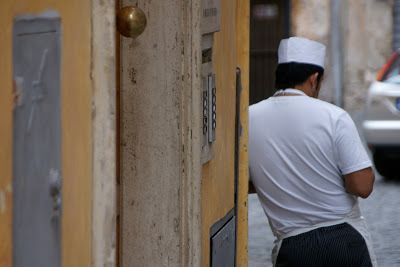
After a long day and an even longer week, I collapsed on the couch with my New Yorkers. Does anyone else feel this way? My New Yorkers. I want to know what these writers know. I want to write a single sentence like they (or some of them) write. I want to give you what I read and think. For now, here is this. It's James Wood talking about Tom Wolfe's latest novel, Back to Blood. Wood is reflecting on details that resonate, those that feel organic, and those that sour the prose with obvious, unlived research. Listen in (for the whole, buy the October 15, 2012 issue):
The important details, the ones that make fiction's intimate palpability, cannot simply be scooped up off the sidewalk. Tolstoy, praised as a realist by Tom Wolfe, took the germ of "The Death of Ivan Ilyich" from an actual story about a judge in a nearby town who had died of cancer; but one of the most beautiful moments in the novella surely came from Tolstoy's imagination—or, rather, from his patient loyalty to Ivan's invented reality. I mean the moment when Ivan Ilyich, lying on his couch, in great distress and loneliness, remembers "the raw and wrinkly French prunes of his childhood, their special taste, and how his mouth watered when he got down to the stone."
Very occasionally in this novel, Wolfe gives evidence that he knows the difference between those French prunes and "Hotchkiss, Yale ... six-three." At one point, Nestor, fleeing the opprobrium of his community, ends up at a favorite Cuban bakery, where he enjoys "a whiff of Ricky's pastelitos, 'little pies' of filo dough wrapped around ground beef, spiced ham, guava, or you name it.... He had loved pastelitos since he was a boy." It's a rare passage without exclamation marks, and superficially it resembles Ivan and the prunes. But the detail about the patelitos has the whiff not of pastry but of research.
[image error]




Published on October 13, 2012 17:32
give yourself the biggest challenge, allow yourself to fear

For my eighteenth book I have given myself the steepest challenge I could imagine. I did this on purpose. I did it because I never want to feel anything less than urgency in writing. I want to feel, in fact, more than a little fear, an ache before the question, Can you actually pull this thing off?
If a book is easy, if it has been done before, if I hear echoes of my own self (or of others) while working, why bother? This is the attitude that I have brought to each book. This is how I am approaching this new one—or will be, once the corporate work has settled.
But glory, every time I think of it, I tremble.
[image error]




Published on October 13, 2012 04:32
October 12, 2012
Push to Publish: The 2012 Philadelphia Stories Conference
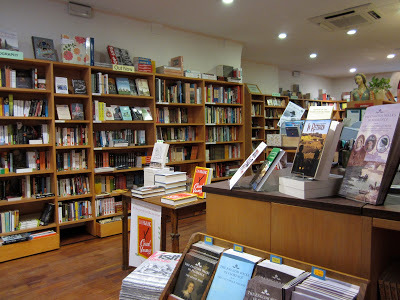
A week ago today I was sitting in this Florentine bookshop (of the Anglo-American variety) interviewing the owners for a forthcoming profile in Publishing Perspectives. Our conversation canvassed many topics. We spoke, in part, about what qualities turn books into the kind book sellers can believe in.
At the annual Philadelphia Stories Push to Publish conference—happening tomorrow, October 13, 2012, Rosemont College, Rosemont, PA—writers, agents, editors, publicists, and readers will be having similarly intense conversations about the making, publishing, and promoting of books. I'll be moderating the "Writing for Children and Young Adults" panel at 2:30, hosting the well-loved Nancy Viau, Catherine Stine, and Alison DeLuca throughout the hour-long conversation. We'll be talking trends (and their antitheses), traditional publishing, e-publishing, and self publishing, slush-pile avoidance tactics, the art of the query letter, and craft, too. We'll definitely talk a little about craft because, well, I can't help it.
We're hoping you'll join us.




Published on October 12, 2012 06:25
October 11, 2012
The Orchardist/Amanda Coplin: a work of utter genius

I had thought, a week ago, that I would dedicate this post to both novels read during (and just after) my trip to Italy, but in my heart there is room for just this one. Amanda Coplin's first novel, The Orchardist, deserves every line of praise you likely have already have read, and I turn, decidedly, from the voices of any who might complain. This is a book of compassionate genius. Period.
The Orchardist is late 19th-century, northwest. There is land. There is a lonesome man, Talmadge. There are two girls, sisters, both of them abused and pregnant and lost. There is an herbalist. There are apples and apricots and lettuce, horses, horse traders, pickers, craters. There are babies, and just one survives.
From these raw elements Coplin produces a portrait of an era complete, shattered, shattering. She dedicates the soul of this book to biblical themes—prodigal children, irremediable sins, revenge and its hollow aftertaste, a father's inequality, unconditional but unspoken love. She writes like very few write, like my friend Alyson Hagy writes—so elegiacally sure, so unafraid, so careful to meet the darkness and to know the darkness and to deliver, nonetheless, blinding light. No one will ever convince me that Talmadge didn't live, or that the baby Angelene isn't living, still, or that somewhere in the northwest, a grove of gnarled trees isn't recalling two ruined sisters.
I have had so much work to do since my return from Italy but I refused to do it until I finished reading The Orchardist. I am in awe of it. I am grateful for it. I believe that this first-time novelist has written a book that any long-time novelist would say, secretly or out loud, That was the one.
A passage:
There was a certain uncanniness Angelene felt opening her closet in the morning, her oatmeal-colored dress hanging in the space on its hanger, her workboots leaning against each other on the porch. (You turned them over and shook them, knocked them on the post, for mice.) The narrow bed with its purple, red, and green quilt, the bedside table with its jar of rocks, piled books. The porcelain basin near the window where she washed her face, the pitcher with the brown rose painted on it, the large crack like a vein in the bottom of the basin. The apricot orchard, the buzzing bees like a haze in spring. The barn–the smell of hay and manure, grease, old leather. The sun streaming through the slats. The mule's nose in her palm.
All of these things she kept inside herself, constantly rearranged them, to create her happiness. Being alone, she was able to see each thing more clearly. Although there was fear in solitude, somehow this only made things sharper.




Published on October 11, 2012 08:03
a perfect twinning, six decades on

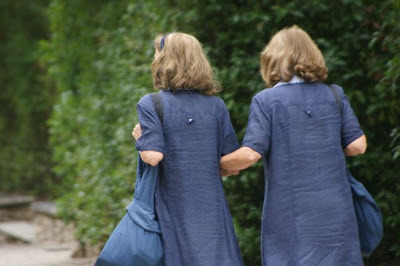
Later today I will attempt (and I will fail) to write about the brilliance of The Orchardist, a first novel that has kept me reading through dark hours. It takes time to find the words for books you so profoundly love, for books that matter as much as this one surely does. I need to find that time.
Between now and then, I share this glimpse of two women who moved me in other profound ways. Their shoes matched, too. Their bags. Their ways of looking at the green and gray world around them. They never let each other go. I met them in the Boboli Gardens, but that's a lie. They only had eyes for each other.




Published on October 11, 2012 05:06
October 10, 2012
celebrating the wisdom of the 2012 National Book Award jurors
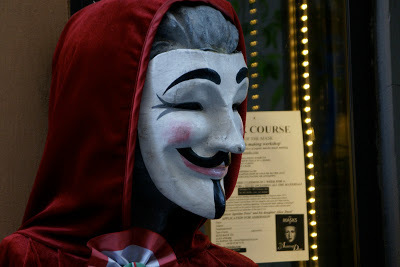
Sometimes book juries convene and read and talk and get things right, and this year the National Book Award judges cited three books that I loved for special recognition.
I am eager to read all the books on all the lists this year. But for now I want to celebrate the honoring of Patricia McCormick for her smart, powerful, daring Never Fall Down (my interview with Patty will soon run on Publishing Perspectives) and Eliot Schrefer for his important Endangered.
In nonfiction, the remarkable House of Stone by Anthony Shadid is a most-deserving nominee. I have highlighted (in this entry) my own thoughts about these books, from posts produced earlier this year.




Published on October 10, 2012 13:44



